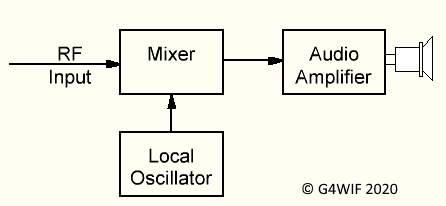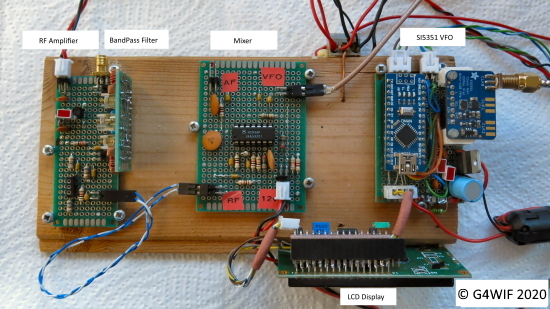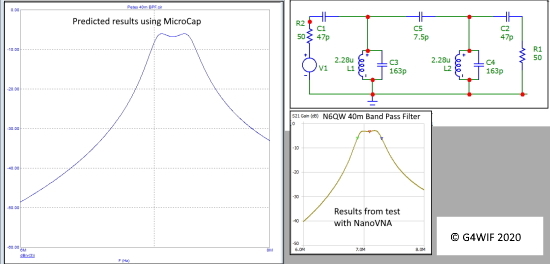Home
February 2021 - N6QW Direct Conversion Receiver
The Spring 2021 edition of the GQRP Club journal SPRAT contained an article penned by Pete Juliano N6QW. A similar article later appeared on Pete's blog.
It rather took his fancy to try out some ideas using a 1496 Double Balanced Mixer chip and provide a simple receiver that could be expanded upon later.
Our esteemed editor of SPRAT, Tex Swann has a small band of proof readers to try to catch typographical errors and so this explains why Nick G8INE and I had early sight of the article. It rather caught our interest too - so we set about each building the receiver using different techniques - but comparing notes as we went.
Those notes grew (quite a bit) - and you can request them if you are interested to see how two other examples turned out. and would then like to try building Pete's design.
A Direct Conversion Receiver is a relatively simple beast and yet perfectly capable of proper communications on the HF bands.

There is no "intermediate frequency stage". The incoming radio frequency signal can however be amplified (as in Pete's design).
Perhaps George Dobbs G3RJV explained it as well as anyone could. In the August 1996 Practical WIreless he said:
The mixer receives the required radio frequency input signal and is also fed with an oscillator signal. The mixed products will include both signals and the sum and difference of both signals.
If the oscillator signal is at the required input signal frequency, the two signals will produce audio heterodynes either side of the required signal. In simple terms an audio signal will then be received on both sides of the input signal.
This is one of the downsides of a DC Receiver - you receive two of everything. The upside is the simplicity and the thrill that you get from impressive results - and from building it yourself.
Here is my receiver in development. It is far easier to fix the modules to a small plank of wood and only later will it make it into a box.
After SPRAT reached members, Pete made his web pages available to everyone - but you will hopefully see that this is very much the kind of construction article that you will find in every issue of Sprat. You are encouraged to join GQRP club so that you do not miss out. This is a quality magazine and the annual cost is less than a single visit to Starbucks.
Nick and I also used the opportunity to learn to use our test equipment better and also to use some of the amazing free software to analyze the expected filter performance before we built it.
Nick G8INE and I have created three documents. (all in PDF format).
The first is a short description of our two builds with photographs.
The second is quite lengthy and as structured as we could make it just simply adding thoughts as we built the receivers. Here we describe how we divided the project into modules and how we tested them. On his website Pete shows how he builds projects and Nick and I have our own methods which show that there are many approaches to homebrewing. We describe our two different techniques and we also show how we design the layout.
There are also some ideas how you might fault-find on your receiver.
The third document contains some additional modules that we built. For instance, alternative audio amplifiers. An alternative VFO.
These three documents can be requested from Tony G4WIF. They are no longer available to download since Pete discovered that a Chinese entity had registered a domain using his callsign and the suspicion was that unathoriased kits based on his design would become available. I did not want to make information pertaining to Pete's designs available to their customers. If you request these documents I will expect you to have some kind of "footprint" that shows that you are an established radio amateur. For instance, a QRZ.COM page that wasn't created a few days ago.
It is all rather regrettable when practically everything except the components and physical PCB were made available to amateurs for free anyway.
We heavily used Printed Circuit Design Software and the files that will enable you to make your own boards are offered if you would like to contact Nick G8INE. The same provisions apply as stated above for the documents.
They were created using Sprint Layout which is a superb piece of software and there is a free display program that will enable you to view and print the files. This will allow you make PCB's at home - or print them out to help lay out components using "perfboard" - which is a method that I used.
Nick will also supply the gerber files which most decent design packages will import.
A little History
Years ago there were UK kits from companies like CM Howes and the original Kanga (owned then by Dick Pascoe and Ian Keyser). Many of us started with one of their Direct Conversion Receivers. Beginning with something simple gives you confidence to try something else - and you learn something along the way.
Conclusions.
In fact you never stop learning and Nick and I certainly found that to be true with this build - and of course, we had fun in the process. Even though we are located some 60 miles apart we prove that it is possible to collaborate and help each other when we get stuck. The Sweeperino, Noise Canceller and SNA Jr projects are just some examples of that. It is a lot easier than building projects on your own.
So especially during those times of lockdown where you couldn't go to your local radio club - or just cannot easily travel that perhaps you can suggest a group project and work remotely as a team.
If you can't do that and need help, then the GQRP club has an online discussion group and we will certainly try answering questions - suggesting solutions to problems that you are having with a build. We also have a number of free technical guides - and we also have our new Youtube Channel.
Pete has designed a simple but very functional radio and if our notes help you build one too, then it will make us very happy.

